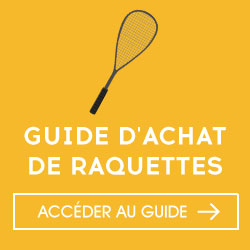Squash racket buying guide
How to choose the right squash racket?
The philosophy of the entire My-Squash team is to provide you with the products best suited to your squash practice, whatever your level of play. The purpose of this squash racket buying guide is to help you make the right choice before you buy. The squash racket is an extension of your arm, so it's an essential part of your equipment.
You will find in this buying guide important information to help you buy the racket most adapted to your needs and expectations.
We are of course at your disposal for any questions you may have about the squash items on offer or to help you in your decision making.
This buying guide is divided into 2 parts:
Are you a beginner? A beginner's guide is available here.
Are you a casual, club or professional player? Go to the 2nd section
The guide to buying a squash racket for beginners
You are about to buy a squash racket for the first time. As long as you like the racket and feel it well in your hand, chances are probably good that you will play well with this racket. What happens if you enjoy the game and want to progress with a racket that best suits your playing style?
As a beginner player, the components to consider are the following: the costs, the shape of the squash racket and its weight.
The budget for a beginner squash racket is between 50 and 100€.
The current average weight is between 130 and 150 grams. The weight shown does not take into account the weight of the string or the extra protection around the frame.
The shape of the racket head plays an important role: the larger the surface of the racket, the greater the chance of hitting the ball.
Here a few examples: Karakal Smash, Karakal Storm, Prince O3 Airo Thunder, Prince Team Adrenalin 400 S, Tecnifibre Carboflex Storm, Tecnifibre Suprem 135 SB, Victor MP 140.
Feel free to test a few squash racquets to see which one best suits your needs.
The guide to buying a squash racket for casual, club or professional players
Squash rackets for club players, competitive players or professional players are individual and personal choices.
The type of string, the profile of the racket, the balance, the handling are all determining elements in the choice of the right squash racket.
The shape of the frame: today there are 2 types. Squash rackets with a racket heart and racket shaped like a water drop.
Squash rackets with a core have a wider string pattern and a larger hitting area. This shape is more tolerant of off-center hits.
Water drop squash rackets have a smaller string pattern and a smaller hitting area which will be more suitable for the more experienced squash player. However, many players turn to drop-shaped squash rackets because they have the advantage of being more maneuverable.
The profile of the frame is essential: some squash rackets have thicker frames than others, which has an impact on stiffness and power output when hitting. The Victor squash rackets are a good example of a high performance wide profile frame.
On the other hand, the Tecnifibre Carboflex 125 X Speed, used today by Mohamed El Shorbagy, for example, has a very thin profile that makes it easier to whip the air and accelerate the head of the racket more easily.
The balance of the racket is something that everyone must define personally. Some players prefer to feel the racket cross the ball when hitting, while others will prefer lighter racket to react faster and accelerate the game at key moments by playing a volley.
One preconceived idea is that the heavier the racket, the more power it produces. This would imply that a light squash racket would lack power. This is no longer the case: today's squash rackets carry technologies that have completely changed the game. The striking zones of squash rackets, also called sweet spot, differ according to the rackets and impact the power of a racket.
Today we can classify rackets into 3 categories according to their balance: squash rackets with weight in the grip (with light racket heads), balanced squash rackets or squash rackets with weight in the head.
It is difficult to say what kind of balance to choose. Historically many professional players favoured heavy head rackets. As the game gets faster and more aggressive, players now turn to more balanced rackets.
The type of string is more important for some players than for others. You should know that it is very easy to change the strings and that the strings present when you buy your squash racket are not the most important element.
There are different types of squash strings and different tensions.
Better quality strings will provide better feel and spin. Concerning durability, everything depends on the gauge: the thinner the string, the faster it will tend to break but the better the feel.
Many people think that the higher the tension of a racket, the more power it produces. This is totally false, it is the opposite!
The tighter a string is, the more you will gain control and lose power. Your string pattern works like a trampoline: when the ball comes into contact with your string, the elastic effect plays an important role in releasing energy depending on the tension of the string.
The maneuverability or playability of a squash racket is perhaps the most important criterion when choosing your squash racket. Each squash racket corresponds to a style of play. The rackets put on sale by the brands are now directly developed with professional players according to their needs. The quality is certainly there and each player can find the racket that suits him best.
Squash racquets all have the same grip size. It is possible to increase the grip size by changing the grip or adding overgrips.


